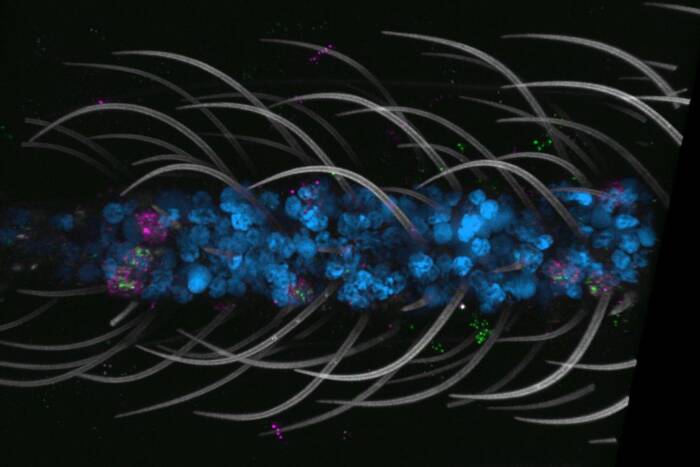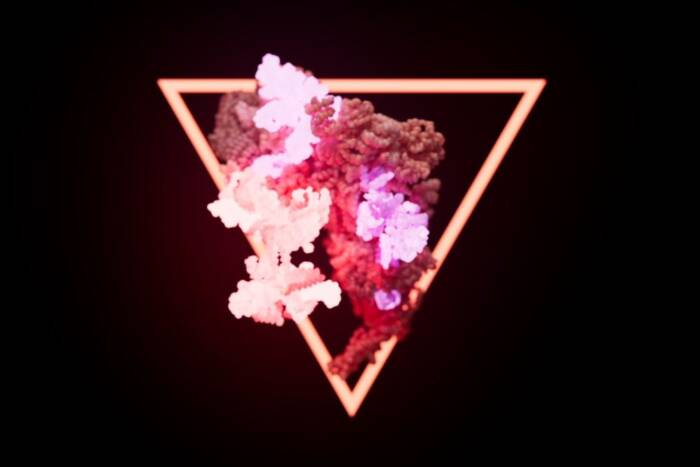Rockefeller particle physicists already at work as LHC particle collider research starts
A team of particle physicists from Rockefeller University watched intently as the Large Hadron Collider, the world’s largest and highest-energy particle accelerator, collided protons at a record energy of 7 teraelectron volts (TeV) yesterday, officially marking the start of the LHC research program.
Scientists expect the energy released by the colliding proton beams to reproduce the conditions that were present a fraction of a second after the Big Bang, allowing for the study of new particles that existed in those primordial conditions and — hopefully — confirming the existence of the elusive Higgs boson. From his lab at Rockefeller, Konstantin A. Goulianos, professor and head of the Laboratory of Experimental High Energy Physics(opens in new window), leads a team whose members are part of experimental groups trying to observe the Higgs at the LHC, located in Geneva, Switzerland, as well as at the U.S. Department of Energy’s Fermi National Accelerator Laboratory (Fermilab) outside Chicago.
“The Higgs particle is highly sought to complete the Standard Model of physics,” says Goulianos. “But there is indisputable evidence that the Standard Model is part of a larger theory, and it is the discovery and characterization of the ultimate theory of matter that propels the current research effort in particle physics.”
 (opens in new window)
(opens in new window)
Collision course. Christina Mesropian and Robert Ciesielski analyze data from proton beam collisions captured by CMS on Tuesday. Yellow arcs trace the paths of specific particles created by the collision.
The Standard Model is a theoretical framework that describes the elementary building blocks of matter, namely quarks and leptons, and their interactions via force carriers called bosons. Although physicists have used the Standard Model to explain and calculate a wide range of particle interactions and quantum phenomena, one crucial component of this theory still eludes experimental verification: the Higgs field. The Higgs field interacts with particles to give them mass and can be energetically excited to appear as a particle called the Higgs boson.
At the LHC, members of the Goulianos lab participate in the c(opens in new window)(CMS) experiment, one of the two largest experiments there. The CMS uses a general-purpose detector designed to investigate a wide range of physics, which includes searches for supersymmetry, a theory that supersedes the Standard Model and predicts a whole spectrum of new particles, extra dimensions and particles that could make up dark matter.
The CMS detector is built around a huge solenoid magnet that takes the form of a cylindrical coil of superconducting cable that generates a magnetic field of 3.8 teslas, about 100,000 times that of the Earth, confined by a 12,500 metric ton steel “yoke.” The detector uses a total of 75 million electronic readout channels that measure the positions of particles with an accuracy of one-tenth of a millimeter. The entire CMS detector was constructed on the surface, and then it was lowered underground in 15 sections and reassembled.
As proton beams are injected into the LHC, and travel through circular 17-mile-long pipes held in a vacuum comparable to outer space, they are guided by superconducting magnets operating at extremely low temperatures. The beams ultimately collide inside the CMS detector, which measures the characteristics of particles produced in the collisions.
The LHC was commissioned in November 2009 with protons colliding at 0.9 and 2.3 TeV, and data collected from these runs has already been published(opens in new window). Tuesday’s 7 TeV collisions were the product of two countercirculating 3.5 TeV proton beams. The LHC will run at 7 TeV until late 2011, followed by a long shutdown to prepare for its run at 14 TeV. At this energy, each beam will carry 7 TeV protons in nearly 3000 bunches. Each bunch will contain as many as 100 billion protons, about 20 of which are expected to collide every time the beams cross. Because the bunches will cross about 30 million times per second, the LHC will generate about 600 million collisions per second.
Anwar Bhatti, an associate professor in the Goulianos lab, serves as group leader of the Rockefeller high-energy physicists working on CMS. Bhatti is working on searches for supersymmetry, leading a group consisting of Research Associate Robert Ciesielski and Postdoctoral Associates Gheorghe Lungu and Sarah Malik. An important part of the work is designing the triggers, the systems that select collisions of interest for further study. “Since only a tiny fraction of the collisions can be recorded, triggers enable the physicists’ computers to rapidly decide which collisions to record,” Bhatti says.
Associate Professor Luc Demortier is a member of the CMS statistics committee, which he chaired during the past two years. The statistics committee deals with the question that every experimental physicist asks: What is the significance of our discovery? With more than 2000 physicists conducting research using CMS data, Demortier says, “the statistics committee receives questions from members and provides input on the significance of the results.”
For more than 20 years, the Goulianos lab has been participating in the Collider Detector at Fermilab(opens in new window), and much of what has been learned there can be carried over to the CMS experiments at the LHC. Christina Mesropian, a research associate in the Goulianos lab, is a convener of the Quantum ChromoDynamics (QCD) group at Fermilab. QCD describes how quarks and gluons interact via the strong force. In addition to its inherent physics significance, research in this area is critical for the LHC because QCD events present the dominant background for many new physics searches, Mesropian says.
Goulianos lab members travel to Switzerland for collaboration meetings and to take shifts on-site as the CMS experiment runs. They also participate in the CMS experiment through a remote operations center located at FermiLab, through frequent video-conferenced meetings with CMS colleagues at the LHC and around the world, and they have real-time access to CMS data from their lab on Rockefeller’s New York campus.
“The Standard Model has phenomenal predictive power, but it is far from the ‘theory of everything,’” says Goulianos. “It does not incorporate gravity and has no obvious explanation for dark matter or dark energy, of which most of the universe is made. The ultimate theory — the ‘DNA of nature’ — is still at large.”


